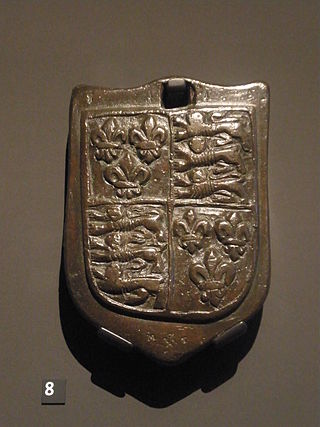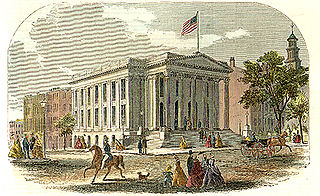Related Research Articles

The imperial system of units, imperial system or imperial units is the system of units first defined in the British Weights and Measures Act 1824 and continued to be developed through a series of Weights and Measures Acts and amendments.

Metrication or metrification is the act or process of converting to the metric system of measurement. All over the world, countries have transitioned from local and traditional units of measurement to the metric system. This process began in France during the 1790s, and is still continuing more than 200 years later, with the modern International System of Units, as the metric system has not been fully adopted in all countries and areas.

The pound or pound-mass is a unit of mass used in both the British imperial and United States customary systems of measurement. Various definitions have been used; the most common today is the international avoirdupois pound, which is legally defined as exactly 0.45359237 kilograms, and which is divided into 16 avoirdupois ounces. The international standard symbol for the avoirdupois pound is lb; an alternative symbol is lbm, #, and ℔ or ″̶.

Chinese units of measurement, known in Chinese as the shìzhì, are the traditional units of measurement of the Han Chinese. Although Chinese numerals have been decimal (base-10) since the Shang, several Chinese measures use hexadecimal (base-16). Local applications have varied, but the Chinese dynasties usually proclaimed standard measurements and recorded their predecessor's systems in their histories.
The long ton, also known as the imperial ton or displacement ton, is the name for the unit called the "ton" in the avoirdupois system of weights or Imperial system of measurements. It was standardised in the 13th century. It is used in the United Kingdom and several other Commonwealth of Nations countries alongside the mass-based tonne defined in 1799, as well as in the United States for bulk commodities.

The stone or stone weight is an English and British imperial unit of mass equal to 14 pounds (6.35 kg). The stone continues in customary use in the United Kingdom for body weight.
The "Plan for Establishing Uniformity in the Coinage, Weights, and Measures of the United States" was a report submitted to the U.S. House of Representatives on July 13, 1790, by Secretary of State Thomas Jefferson.
A system of units of measurement, also known as a system of units or system of measurement, is a collection of units of measurement and rules relating them to each other. Systems of measurement have historically been important, regulated and defined for the purposes of science and commerce. Instances in use include the International System of Units or SI, the British imperial system, and the United States customary system.
The Metric Martyrs was a British advocacy group who campaigned for the freedom to choose what units of measurement are used by traders. The group believed that vendors should have the freedom to mark their goods with imperial weights and measurements alone. This opposes the current legal position that imperial units may be used so long as metric units are also displayed.
The spread of metrication around the world in the last two centuries has been met with both support and opposition.

Metrication in Canada began in 1970 and ceased in 1985. While Canada has converted to the metric system for many purposes, there is still significant use of non-metric units and standards in many sectors of the Canadian economy and everyday life today. This is mainly due to historical ties with the United Kingdom, the traditional use of the imperial system of measurement in Canada, proximity to the United States, and strong public opposition to metrication during the transition period.

Metrication, the process of introducing the metric system of measurement in place of imperial units, has made steady progress in the United Kingdom since the mid-20th century but today remains equivocal and varies by context. Most of government, industry and commerce use metric units, but imperial units are officially used to specify journey distances, vehicle speeds and the sizes of returnable milk containers, beer and cider glasses, and fresh milk is often still sold in multiples of pints, with the metric equivalent also marked. Imperial units are also often used to describe body measurements and vehicle fuel economy. In schools, metric units are taught and used as the norm. Imperial units that remain in common usage in the UK are also taught.
Metrication, or the conversion to a measurement system based on the International System of Units (SI), occurred in India in stages between 1955 and 1962. The metric system in weights and measures was adopted by the Indian Parliament in December 1956 with the Standards of Weights and Measures Act, which took effect beginning 1 October 1958. The Indian Coinage Act was passed in 1955 by the Government of India to introduce decimal coinage in the country. The new system of coins became legal tender in April 1957, where the rupee consists of 100 paise. For the next five years, both the old and new systems were legal. In April 1962, all other systems were banned. This process of metrication is called "big-bang" route, which is to simultaneously outlaw the use of pre-metric measurement, metricate, reissue all government publications and laws, and change the education systems to metric.

New Zealand started metrication in 1969 with the establishment of the Metric Advisory Board (MAB) and completed metrication on 14 December 1976. Until the 1970s, New Zealand traditionally used the imperial system for measurement, which it had inherited from the United Kingdom.
There are a number of Spanish units of measurement of length or area that are virtually obsolete due to metrication. They include the vara, the cordel, the league and the labor. The units of area used to express the area of land are still encountered in some transactions in land today.

The following outline is provided as an overview of and topical guide to the metric system:

The imperial and US customary measurement systems are both derived from an earlier English system of measurement which in turn can be traced back to Ancient Roman units of measurement, and Carolingian and Saxon units of measure.
The History of measurement systems in Pakistan begins in early Indus Valley civilization when pastoral societies used barter to exchange goods or services and needed units of measurement.
A number of units of measurement were used in Estonia to measure length, mass, area, capacity, etc.
A number of units of measurement were used in Peru to measure length, mass, area, etc. The Metric system adopted in 1862 and has been compulsory since 1869 in Peru.
References
- ↑ "Metrication - Europa". Metric Pioneer. Retrieved 8 February 2015.
- 1 2 Clarke, F.W. (1891). Weights Measures and Money of All Nations. New York: D. Appleton & Company. p. 68.